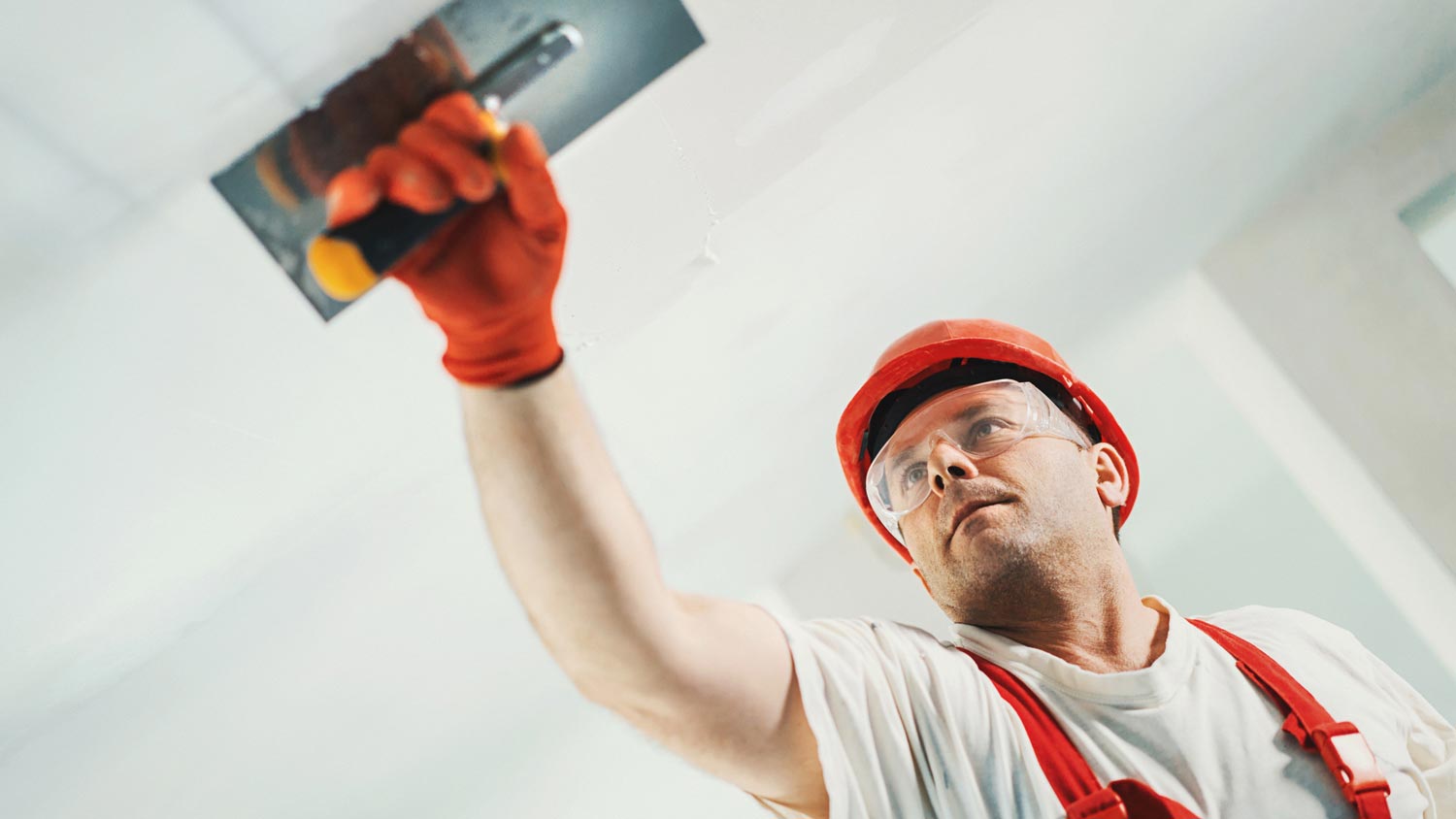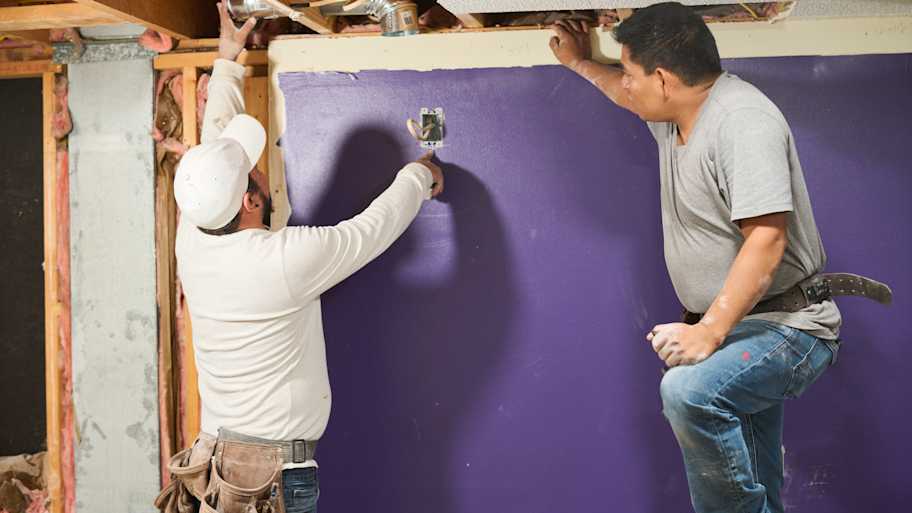Drywall Finish Levels: A Complete Guide
Should your new drywall get one coat of mud or two?


Drywall industry leaders developed six levels of drywall finishing.
The lowest level requires no finishing.
The majority of drywall projects require Level 4 finishing.
Hanging the drywall is just the beginning. Once you've hung it, the next step is to finish it. The Gypsum Association, Drywall Finishing Council, and other industry leaders have developed standards for drywall finish levels that clearly define finishes and make it easier for homeowners to communicate their wishes to contractors. From Level 0 to Level 5, learn what's expected of each type of finish.

Level 0
Another way to describe a Level 0 drywall finish is "no finish." At Level 0, the drywall panels are bare, with no taping or mud. Level 0 drywall finishing is reserved for areas out of the public eye or temporary installations. It can also be used as a placeholder until you decide what you want to do with a space.
Level 1
The next level up, Level 1, is a little more finished, but barely. The seams and angles are taped, but there’s no mud coating on top of the tape.
At this level, the screws are left uncoated. Excess joint compound or mud from the tape is cleaned up without sanding.
Level 1 drywall finishing is best for walls in out-of-the-way areas. While you wouldn't choose Level 1 for the walls of your bedroom or living room, you could use it in a garage or unfinished basement.
"Joint compound" and "drywall mud" are often used interchangeably when explaining drywall projects. That's because they're referring to the same thing—"drywall mud" is simply a more colloquial term.
Level 2

Things get smoother starting with Level 2. Along with taped seams and angles, Level 2 finish sees the addition of a thin coat of joint compound or mud, enough to cover the tape and any screws. There's no need to sand for a Level 2 finish.
Level 2 can be a good choice for basements and garages. It's also appropriate if you’re covering the drywall with another material, such as tile or wainscoting. If you plan to install cabinets over the drywall, there's no need to finish the drywall behind those cabinets beyond Level 2.
Level 3
Level 3 drywall finish smooths things out even more. At this level, you add another coat of mud over the first layer, fully covering the seams and screws. You also sand the compound between coats and again after the second coat. A skilled and experienced drywall installer near you can take on the job and create a smooth and finished surface.
Unlike the first three finish levels, you can use Level 3 in interior areas, such as your living room and bedroom walls. If you're going to stop at Level 3, though, just ensure you're coating the drywall with something textured, such as wallpaper. While Level 3 is smoother than some options, it's still a little rough around the edges.
Level 4

For most painted drywall projects, Level 4 is the target level. Here, things are smooth, smooth, smooth. At this stage, you apply a third coat of joint compound to the screws and between one and two coats to the joints and angles. Then, you sand everything down until there are no bumps or ridges.
Level 5
The top level of drywall finishing, Level 5, adds one final skim coat, making the walls as smooth and even as possible. It's the level of choice for interior walls under bright lighting or with high-gloss paint. Your walls will be ready for their close-up with a Level 5 finish.
The goal of a Level 5 finish is to prevent any imperfections from showing on the drywall's surface.
How to Apply Drywall Finish: 3 Ways
There are several different ways to apply the final drywall finish, and your choice will depend on your skill level and the supplies you have.
Roller: To apply the final skim coat, you can use a roller to roll thinned-out joint compound to the entire wall, immediately smoothing and scraping any excess to create a smooth, flat surface.
Taping knife: Throughout the drywall finishing process, you’ll use a taping knife to add joint compound to the seams and smooth out the coats that cover the tape. For Level 5 finishes, you can also use a taping knife to smooth the drywall compound across the entire wall.
Spray finish: A spray finish is ideal for large jobs. It requires spray equipment to apply an even layer of drywall compound to the wall and create the final product.
How to Choose a Drywall Finish Level
How you plan to use the room and what will happen to the drywall after installation will help you determine which finish level is right for your project. If you cover the wall with fixtures such as cabinetry, there's no need to get a completely finished surface—Level 2 or 3 will suffice. The same is true if you install a backsplash on top of the drywall or cover it with paneling.
Areas that get a lot of light exposure will need a higher finish level. For example, even if you choose Level 4 for the rest of the room, you may want to use Level 5 on a ceiling since light reflects off of it and shows imperfections.
Save Level 1 and Level 0 finishes for rough spaces, such as your attic, garage, or unfinished basement.
Frequently Asked Questions
Level 4 is the most commonly used drywall finish for visible interior walls. Finishing the drywall to Level 4 rovides a smooth surface ready to be painted with flat paint.
Level 2 and 3 finishing are also common, particularly on walls that will get covered.
If you're comfortable hanging drywall yourself, you may be comfortable finishing it. But it's worth noting that finishing drywall adds several steps to the process and a lot of waiting time. Hiring a drywall installer may be the way to go if you'd rather spend your time doing other things or are nervous about leaving a rough surface.
How you hang the drywall can affect the finishing process. It's often easier to finish horizontal drywall panels, as the seams run across the wall rather than up and down. Standard drywall panels are 48 inches wide, so the seam is easy to reach without bending down or stretching your arms.
















